MSI Z87I Review: Mini-ITX Haswell for $140
by Ian Cutress on August 27, 2013 10:15 AM EST- Posted in
- Motherboards
- MSI
- Mini ITX
- Z87
MSI Z87I BIOS
As this is our third MSI 8-series motherboard reviewed, we get a third crack that the MSI Click BIOS 4. Whereas previously we had seen the gaming editions run a red dragon color scheme and the overclocking motherboards run yellow, when it comes to the ‘classic’ range we get a wide eyed blue. Nevertheless, the functionality is pretty much the same as the other motherboards. The only significant deviation I was able to find was that the Z87I had an upper limit when it came to CPU voltages – 1.3 volts on the i7-4770K. This is actually a good idea on a mini-ITX board, although for users wishing to push boundaries it would be nice to have an ‘advanced OC’ switch to increase this value even more. Users who feel adventurous can up the CPU voltage using OS software even further.
Nevertheless, as a functional BIOS the Z87I does have some merits which we alluded to in our previous MSI BIOS rundowns:
Like the Z77 BIOSes from MSI, the main selling point is the ribbon of information along the top – we get details of the motherboard being used, BIOS version, CPU installed, current speed, memory size and also memory speed. Ultimately all we are lacking is CPU voltages and fan speeds, but there is also perhaps another issue – this ribbon is quite big. Keeping it this size and keeping it a consistent part of the display means that everything else is squashed and it becomes an effort to fit everything in. A few manufacturers that are going down this route are keeping the ribbon small enough to make sure that the actual ‘options’ area of the BIOS have plenty of space.
Aside from the ribbon we have a standard MSI layout of six buttons around the edge and the main options in the middle. For Z87 the options have changed slightly, with the main two additions being Hardware Monitor and Board Explorer. Hardware Monitor is actually an awesome way to organize your fan controls from the BIOS:
While the level of control is quite small (a two point gradient, no hysteresis, BIOS engineers confusing power applied to the fans as directly proportional with the actual RPM), the execution of visually showing the fan controls is one of the best we have seen. By moving the sliders in the ‘fan control’ section around the graph changes to show what is actually happening. Aside from the power-to-RPM issue (which should be inexcusable in 2013), what we need here is more control – more points in the gradient to deal with, as well as hysteresis and manual control over the points on the graph. Then perhaps MSI would be onto on overall fan control success.
The second new feature of the BIOS is Board Explorer, which mimics features we originally came across in other manufacturer BIOSes:
Here is a visual representation of the motherboard, and everything on board which has something plugged in comes up blue. My moving the mouse over an area we get an explanation of the hardware plugged in with the hardware string assigned by the manufacturer. Moving to the SATA ports or IO panel and clicking brings up an additional visual showing which ports are in use:
I am glad this is a feature becoming standard. It ultimately helped when I received the ES version of this motherboard into the office and one of the PCIe did not work – I was able to diagnose this issue through Board Explorer. If hardware is not seen here, then it was not recognized by the motherboard at POST time.
For the rest of the BIOS, we have typical MSI fare. Most of the regular options available to the user are in Settings, including SATA configuration and turning on/off controllers:
A nice positive is the Boot Override, also slowly becoming standard across all manufacturers allowing a one type boot from a secondary device.
As on the previous MSI Z77, our OC options are almost a complete jumble, although I am told that the BIOS engineers are working on a more sophisticated layout:
There is some sort of order, but it would be ideal to actually have headings like the Integrated Peripherals menu in standard Settings, such that CPU overclocking features are separate from the DRAM options and then voltage options inserted into the appropriate places. As it stands the MSI BIOS looks like a higgledy-piggledy jumble to a new overclocker. One of the positives on the Z87 generation at least is the addition of the information panel on the right hand side, allowing users to see a small amount of information on each option. Ideally this side panel should also show the min, max, interval and ‘suggested value’ for each option to assist overclockers, but that may appear in another update. It should also be pointed out that for some of the options, there is almost no guidance – it merely repeats the option listed or says ‘Adjust X’, which is not particularly helpful to anyone but the BIOS engineer.
One additional option that MSI should consider is a greater range of automatic overclocking options so users can select between 4.0 and 4.5 GHz in 100 MHz jumps with just an option selection in the BIOS. This would aid users in finding out how to overclock the CPU a bit more, and can work side by side with OC Genie.


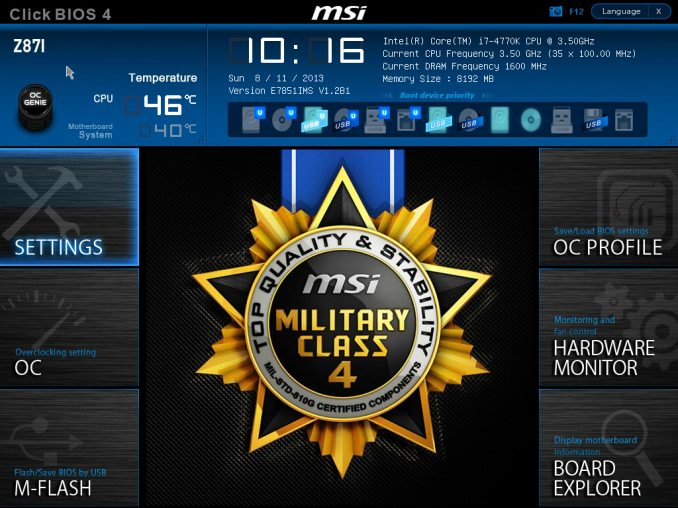
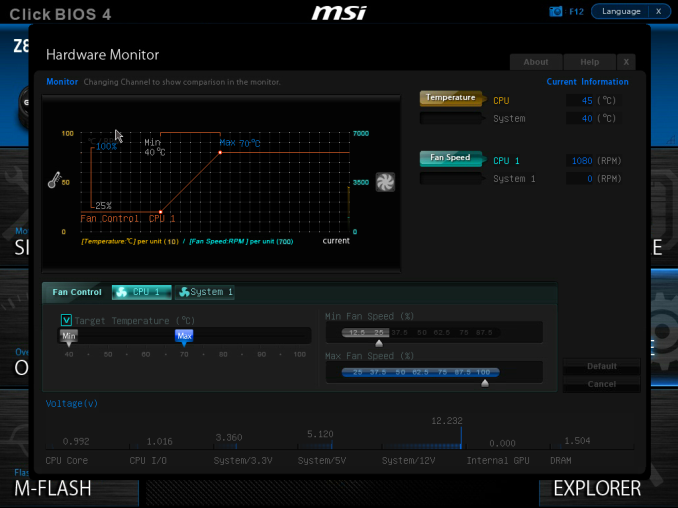
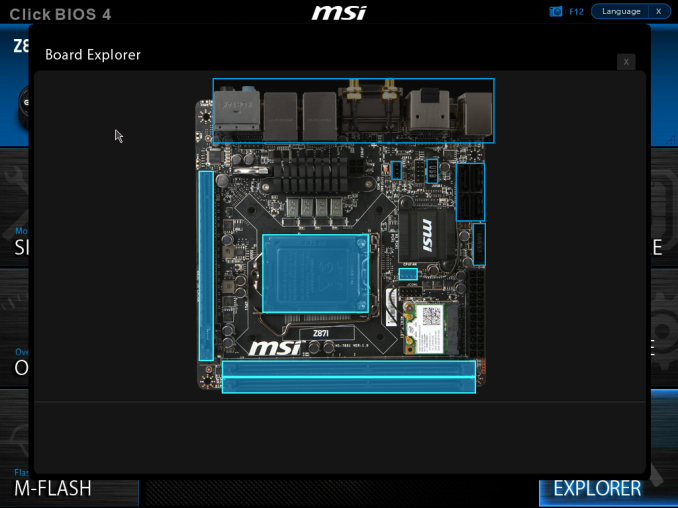

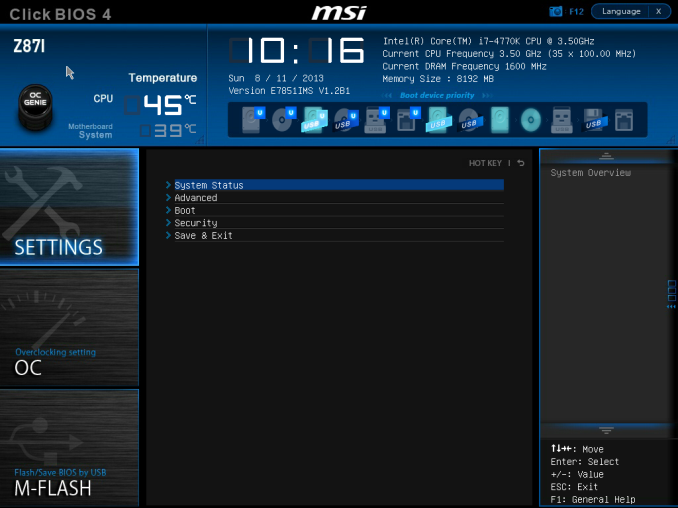
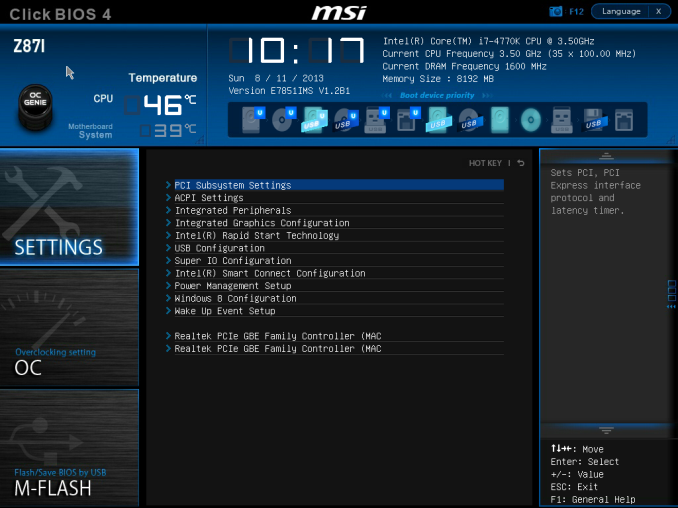
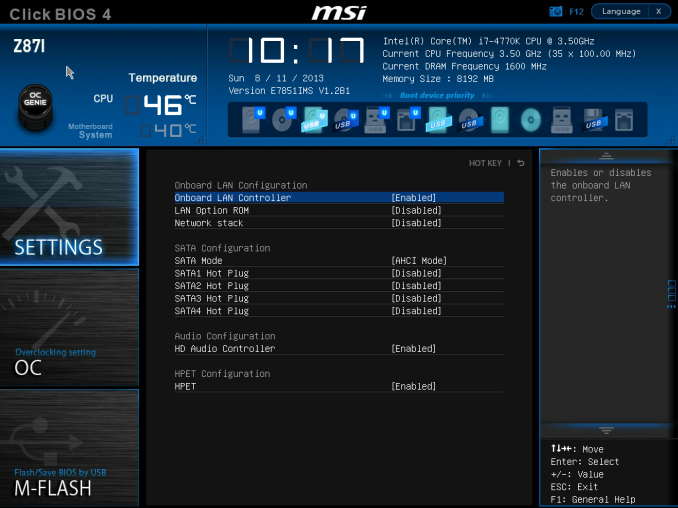
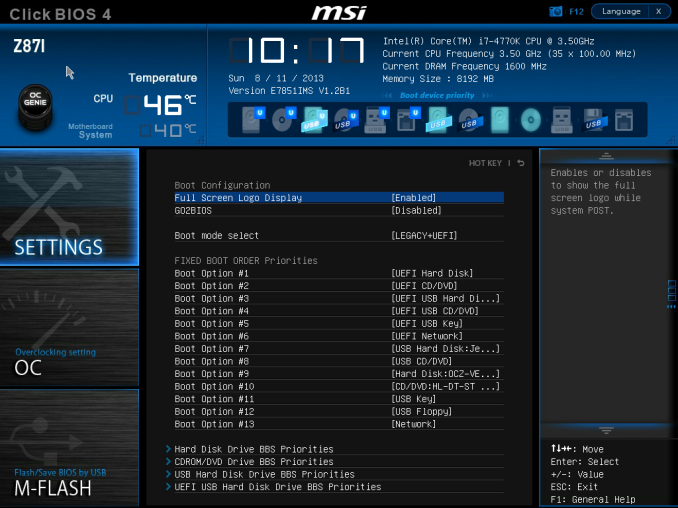
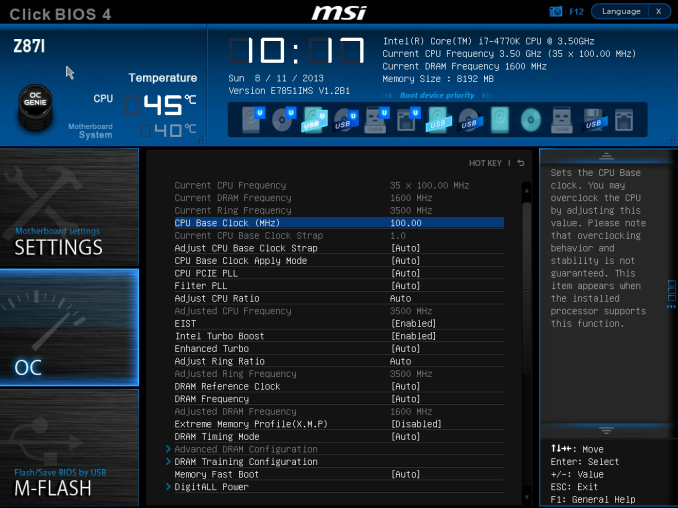
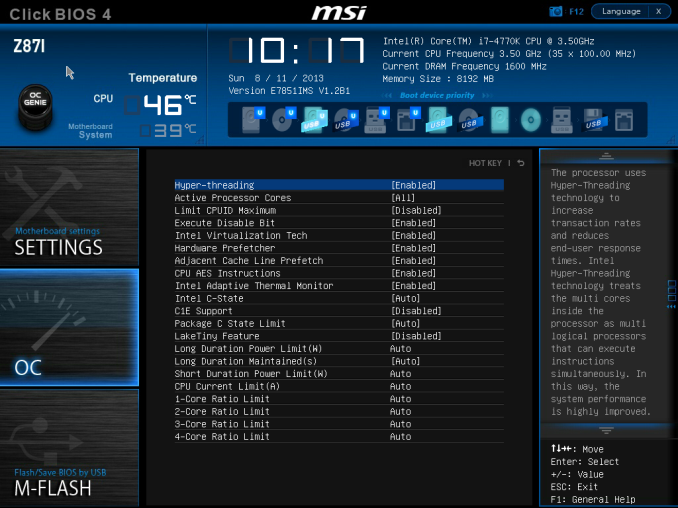
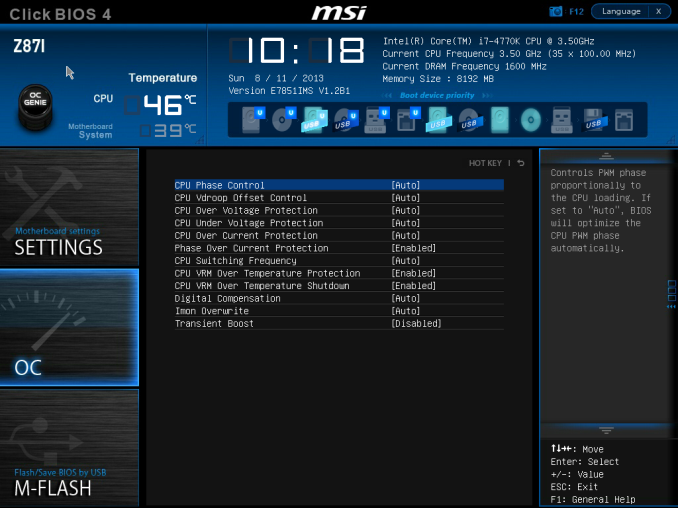















46 Comments
View All Comments
Meaker10 - Wednesday, August 28, 2013 - link
No they are not, while the devices will plug into both slots, a mSATA drive will not work in a mini PCI-E slot and a mini PCI-E card will not work in an mSATA slot meaning they are physically compatible but not electrically compatible.There are a few SSDs that have a SATA to PCI express bridge and these will only work in mini pci express slots and wont be bootable.
Jason33 - Wednesday, August 28, 2013 - link
mSATA and mPCIe are electrically compatible. You only need to mux the data signals on the motherboard to either go to the SATA controller or the PCIe controller.Using this mux chip on the motherboard would work: http://www.nxp.com/documents/application_note/AN11...
Meaker10 - Thursday, August 29, 2013 - link
Yes they are compatible with a MUX, so how is that going to help with an mSATA/PCI-E slot that is not muxed?I have yet to see a consumer device with that muxed in so it's a pointless argument to make.
Jason33 - Thursday, August 29, 2013 - link
Several ThinkPads and notebooks for a few years now have done this. I'm running an mSATA drive in my ThinkPad that used to have a mPCIe WWAN card. There are also mini motherboards that can accept either type of card.Jason33 - Friday, August 30, 2013 - link
Also, I do agree that slots that don't have a mux will only allow one type of card. However, most consumer boards, notebooks and pre-built systems I've personally encountered that support mSATA cards also support mPCIe cards for the same slot.To answer kwrzesien's original question, MSI doesn't advertise it as supporting mSATA. If it did, they'd definitely say so. No reason to not advertise a feature. If you really want a Z87 ITX board with an mSATA slot then the ASRock Z87E-ITX has a full height mSATA/mPCIe slot in addition to the half height mPCIe slot holding the 802.11ac WiFi module.
1Angelreloaded - Thursday, August 29, 2013 - link
You are right and wrong, MSATA was initially made to use as a caching flash for Laptop hardrives, an MSATA port is different from MPCIe look at the combo card Asus gives in its ROG series Mobos, trust me they are incompatible.1Angelreloaded - Thursday, August 29, 2013 - link
No different channel slot type , do yourself the favor pay 50$ more and get the Asus Maximus Impact, much better.DanNeely - Tuesday, August 27, 2013 - link
Something's not consistent here:6 x USB 3.0 (Chipset) [4 back panel, 1 header]
4 x USB 2.0 (Chipset) [2 back panel, 2 header]
Assuming the totals are correct you're counting USB3 headers on one line, and USB2 ports from headers on the second.
IanCutress - Tuesday, August 27, 2013 - link
Ah yes, I normally have a header equal to two ports unless otherwise stated. Table is fixed.Ian
The Von Matrices - Tuesday, August 27, 2013 - link
Unfortunately a few of the motherboard articles posted in the past few weeks are incorrect regarding the Flex IO configuration. In this article, it states "This amount of extra network controllers is due to the Flex IO allocation – as the board only has four SATA 6 Gbps and six USB 3.0 from the chipset, this gives the other 8 Flex IO lanes all the PCIe 2.0 for these controllers." However, the Flex I/O allocation in the specifications table states that there are 6/4/8 SATA/USB 3/PCIe 2.Similarly, the review of the ASRock Z87 Extreme6/AC is incorrect in this regard as well. It states that "Out of our total 18 PCH Flex IO ports on board, this means we have six for SATA 6 Gbps ports, we also have four for USB 3.0 (PCH are headers, ASMedia on Rear IO) leaving eight for PCIe 2.0 lanes." I own a Z87 Extreme6, and I can tell you that this is not correct. The Flex I/O allocation in this board is 6/6/6 SATA/USB 3/PCIe 2. The rear USB 3.0 ports are driven by an ASMedia ASM1074 USB hub, not an ASMedia PCIe USB 3 controller, as would be implied by the Flex IO table in the article.